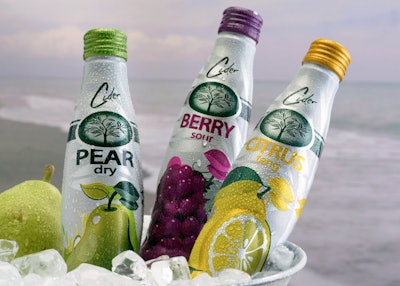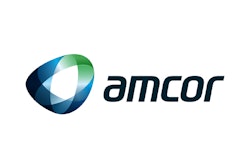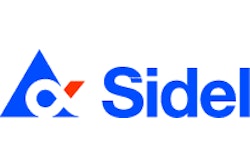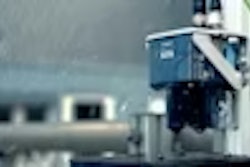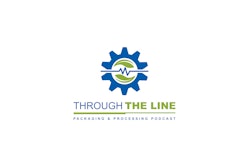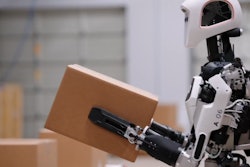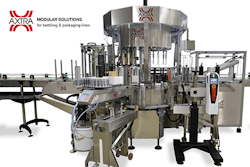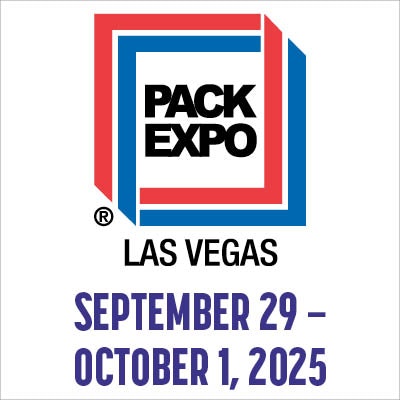If you like learning about innovative new packaging technologies on the cusp of commercialization or those making a splash on-shelf, The Packaging Conference has become the event to attend each year. The 2018 edition, held in Orlando in February, featured news on the commercialization of a form/fill technology that TPC has followed for several years, an innovation that makes possible a handled PET container, a new aluminum technology where bottles are blow-molded into shapes previously only possible with PET, and a new bottle-to-bottle recycling process.
The conference is organized by PTI, formerly Plastic Technologies, Inc., and SPA-CCI. A source for breaking news on the packaging industry, TPC had some news of its own this year: Peter J. Fahnenbruch, Business Manager for PETnology/tecPET GmbH announced that TPC and PETnology will be partnering to present the first edition of PETnology Americas 2018, June 25-26, in Atlanta.
Hand-soap bottle first to use form/fill process
Since 2015, LiquiForm Group® LLC has been a part of the TPC agenda, providing updates on its progress toward commercialization. So, it was only fitting that at this year’s event, Saxena Ashish, Vice President and General Manager of LiquiForm, should unveil the first commercial package made with the form/fill process. While Saxena did not reveal the name of the end user, a press release issued the following day provided details on the package, a 12-oz PET bottle for the Nature’s Promise brand of hand soap.
The package was produced on a proprietary, Amcor-built machine powered by the LiquiForm process. Says Amcor, the new machine is the industry’s first manufacturing unit to successfully use LiquiForm. At PACK EXPO Las Vegas 2017, Amcor Limited, the parent company of LiquiForm Group, shared that it had also licensed the technology to four other OEMs and converters to move it forward more rapidly. These include Sidel, KHS Corpoplast, Krones, and Japanese converter Yoshina Kogyosho Co.
For the Nature’s Promise bottle Amcor partnered with GreenBlendz, a Michigan-based co-packer and developer of private-label, environmentally-friendly consumer products. The bottle, which contains 50% post-consumer recycled content, is a drop-in replacement for the former Nature’s Promise container and uses the existing closure and label.
Said Steve Berry, founder and COO of GreenBlendz, in the announcement on the launch, “We’re excited to be a partner in the commercial validation of such a highly sustainable manufacturing process. LiquiForm technology delivers enormous efficiencies throughout the supply chain and improves the industry’s carbon footprint.”
LiquiForm technology uses the packaged product instead of compressed air to simultaneously form and fill containers. In this case, the hand soap essentially forms its own rigid PET container. By combining the forming and filling into one step, the process eliminates costs associated with the equipment and energy of the traditional blow-molding process along with the handling, transport, and warehousing of empty containers.
“LiquiForm has the potential to revolutionize the filling and packaging industries with a more flexible, efficient, and sustainable supply chain,” said Ann O’Hara, Vice President and General Manager of Amcor Rigid Plastics’ Diversified Products Division in the announcement. “The development and launch of the first commercial manufacturing machine and the introduction of the first commercial product represent two major milestones for the LiquiForm technology.”
According to Amcor, the forming of bottles with the LiquiForm process also opens new pathways toward lighter, more sustainable packaging. Lighter-weight containers, achieved through improved consistency in wall thickness, combined with a reduction in the transport of empty containers, reduces environmental emissions and lowers the carbon footprint. The LiquiForm process also offers the potential to reconfigure supply chains and move packaging closer to the market, resulting in strong logistical benefits and further carbon footprint reductions.
Explained Saxena, LiquiForm has worked with most standard resins, as well as most stock preforms, without issue. The process has also been used with a range of product viscosities, including a thick conditioner. “We continue to do more and more work to push the boundaries to make the technology fit for all packages and applications,” he said. “But the good news is that we haven’t hit a wall yet. Our aim is to do even smaller and larger packages.”
As predicted by O’Hara at TPC 2015, commercial momentum for the LiquiForm process is now underway and accelerating. “Interest from Fortune 500 companies is growing by leaps and bounds,” said Saxena. “Almost all of them come away with the impression that liquid forms better than air.”
PET container with integrated handle available in 2-L
They said it couldn’t be done. But Pretium Packaging proved them wrong, launching the first PET container with integrated handle in summer 2017. At TPC, Pretium announced it has added another size, a 2-L version, to its existing 64-oz SureHandle™ PET container platform.
At TPC, Pretium President & CEO Paul Kayser spoke on the genesis of the handled container, which uses technology from Practically Impossible Labs. Pretium is one of the largest custom blow molders in the country. Said Kayser, “We try to anticipate market needs and look for technology platforms to be able to deliver market solutions.”
He added that Pretium is especially interested in creating disruptive technologies. To be disruptive, he said, a technology must achieve certain objectives. Among them:
- Shelf-differentiating
- Convenient
- Portable
- Attractive
- Able to go in the recycling stream
- User friendly
- Customizable to meet brand goals and market demands
“I believe we have achieved all of this with SureHandle,” said Kayser.
Over the years, there have been a variety of attempts to develop handled PET containers, but most have fallen short of the mark. SureHandle technology creates new possibilities for many products—including beverages, foods, and household and industrial chemicals—that could benefit from a monolayer container with an ergonomic handle.
The container combines preform technology developed by PI Labs along with Pretium’s injection and blow-molding manufacturing expertise. The capability begins with the preform, which is structurally different than the traditional straight-sided, injection-molded preforms used to blow mold PET containers. This preform features an injection-molded handle attached to the sidewall.
“One of the inherent benefits of the container is strength,” said Kayser. “The handle almost acts as a flying buttress. It provides tremendous compression strength. We believe we can shrink-wrap bottles in tray packs and stack them up to five pallets high. This provides a lot of logistics benefits.”
In a press release from PI Labs issued immediately following Kayser’s presentation, company President Bill Duelge reiterated the importance of the SureHandle’s compression strength. “The challenge to eliminate single-use corrugated in the retail channel is upon us. PET containers are an obvious answer to that challenge, but the incorporation of an ergonomic handle with improved durability and transport packaging elimination create exciting new opportunities for everyone involved,” he said.
The SureHandle is currently available in monolayer PET only, but Pretium has partnered with several vendors/suppliers that can provide additives such as UV inhibitors and oxygen scavengers to address barrier needs. Unlike two-piece handled containers, which typically are made from more than one material, the integrated PET handle/body combination is made solely from PET, which facilitates recycling. A monomaterial structure means the bottle does not have the potential to contaminate the PET recycling stream.
The new 2-L stock container size introduced at the conference is three-quarters of an inch taller than its 64-oz counterpart. Brand owners in several food categories, including edible oil and honey, have shown interest in this new size. Olive oil, for example, is typically filled in countries using the metric system. The 2-L also is ideal for honey containers used in foodservice and other institutional environments. Other product possibilities include cold-pressed juices, ready-to-drink teas, sports drinks, nutritional supplements, dressings, sauces, marinades, etc.
Recently, the SureHandle container also received validation by The Packaging School at the Rochester Institute of Technology that it can be used for high-pressure processing (HPP) food and beverage applications. Because HPP does not rely on heat for pasteurization, this validation opens the door for products that are using this relatively new cold processing pasteurization to go to market in an equally new, disruptive container that will protect their nutritional and flavor profile. An additional benefit is that the cold processing enables the use of less-expensive, linerless plug seal-style closures.
Said Kayser, SureHandle containers create multiple marketing opportunities for brand owners seeking to appeal to a wider audience. The container is easier to handle for both younger children and older adults, and for those with physical challenges, compared to pinch-grip or straight-sided alternatives. The handle not only provides carrying advantages, but also improved pouring control. It has been engineered for products needing fill temperatures up to 120°F and can accommodate an induction seal or foam liner.
As to when the first commercial application will be launched, Kayser noted that several customers are currently running it through their validation systems. In the meantime, Pretium will continue to work with PI Labs to develop the next generation of handles. Said Kayser, “We believe handles can be adjusted, but we have some development work to do on that.”
Bottle technology ‘makes aluminum act like plastic’
Betty Jean Pilon, President of Montebello Packaging, began her presentation—“uShape Aluminum Bottle Technology Creates Unique Branding Opportunities”—by sharing with the audience that she does not usually speak at conferences. But, she explained, she felt her company’s new technology was so exciting, she had made an exception. And she delivered.
Montebello has traditionally been known as a supplier of collapsible aluminum tubes, aerosol cans, laminated tubes, and all-plastic tubes. However, Pilon said when the company saw a downturn in its market, it looked to new packaging innovation. The company’s new uShape technology, in development for 10 years, was driven by the tremendous opportunities presented by the beverage market.
“We know that Canada, the United States, China, and Brazil are the largest beverage markets in the world,” said Pilon. “They singlehandedly produce 100 billion bottles each year. The Europeans consume about 63 billion, the South Americans about 32 billion, and the rest of the world, approximately 20 billion. So that’s why we got into it.”
The advantage of the patented uShape technology is the ability to create aluminum bottles with shapes previously possible only with PET, with the features and functionality of aluminum. To create uShape, Montebello partnered with Novelis, taking their patented technology and building upon it. The bottle is made from impact-extruded aluminum that is turned into a preform and blow molded “in any shape you’d like,” said Pilon. This includes flutes and asymmetric shapes. She added that the process is very quick, and the molds are inexpensive. Another advantage is that Montebello can produce minimum runs of 30,000 pieces versus the hundreds of thousands required by traditional can manufacturers.
The bottles can be dry offset-printed by Montebello in up to nine colors and can include matte and gloss finishes, metallic and specialty inks, and a variety of base-coating options. The bottle can also be embossed or debossed and can accommodate ROPP, crown, and ring-pull closures.
“It’s fun that we’ve been able to create something that allows people to use their imagination to innovate something they want to see on the shelf,” said Pilon.
Montebello has taken the concept out to the market in the last six months, receiving technical innovation awards in both the U.S. and Europe. According to Pilon, several customers are now in stability testing with the new bottle.
uShape is suggested for a range of applications, including energy and sports drinks, dairy beverages, iced tea and coffee drinks, and carbonated soft drinks, among others. “Craft brewers love it,” said Pilon. “They can do short runs and it is very cost effective. The biggest cost is not the process, it’s the aluminum.”
Low carbon-footprint bottle-to-bottle rPET plant
Fledgling company rPlanet Earth (rPE, 310/527-0733) is on a mission to revolutionize the way PET is recycled and put back into packaging. rPE’s model is to recycle post-consumer PET, including water and soda bottles and thermoformed containers, into a bottle-grade flake that exceeds FDA requirements for direct food-contact applications. The company will then use the rPET flake to manufacture high rPET-content bottle preforms, sheet, and thermoformed products for food, beverage, cosmetics, and other packaging applications.
What’s unique about rPE’s process, Robert Daviduk, co-CEO of rPE, told TPC attendees, is its low carbon footprint versus traditional PET recycling and rPET package manufacturing methods. With traditional processes, one facility sorts, grinds, and washes the PCR PET, another decontaminates and pelletizes the material, and a third produces the rPET preforms or sheets. With the rPE process, all steps are done in one location, with the exception of pelletization, which is not required.
As Daviduk explained, removing the pelletizing process not only reduces energy—the process uses 22% less—but also eliminates the heating and melting step, thereby avoiding unnecessary PET degradation and resulting in rPET with greater clarity.
Among the advantages of having all steps in the process housed under one roof, Daviduk added, are the elimination of intermediate supplier mark-ups and transportation costs, and the removal of costly production steps.
Said Daviduk, from the rPET flake, the company will produce very high-quality bottle preforms, sheet, and thermoformed containers with excellent color and clarity characteristics. These include clamshells, deli rounds, beverage cups, and more, using customized blends of rPET and virgin PET that can include anywhere from 25% to 100% rPET. The company will also be offering wash-away labels for recycling.
rPE is already underway with construction on its first plant in Vernon, CA, a custom-built, 302,000-sq-ft plant that will operate two recycling lines supplied by Krones. Phase 1 will become operational in summer 2018, Phase two by year-end 2020. Each line will have the capability to produce 80 million lb of finished product per year.
“Upon completion of the Phase 2 expansion, by volume the plant will be the largest food-grade rPET plant in the U.S. and the second largest in the world,” said Daviduk. rPE hopes to eventually open four to five facilities in all, strategically located across the U.S. in high population areas.
